Fact: my wife said she would toss her candy stash if this summer chicken salad is in the fridge all the time.
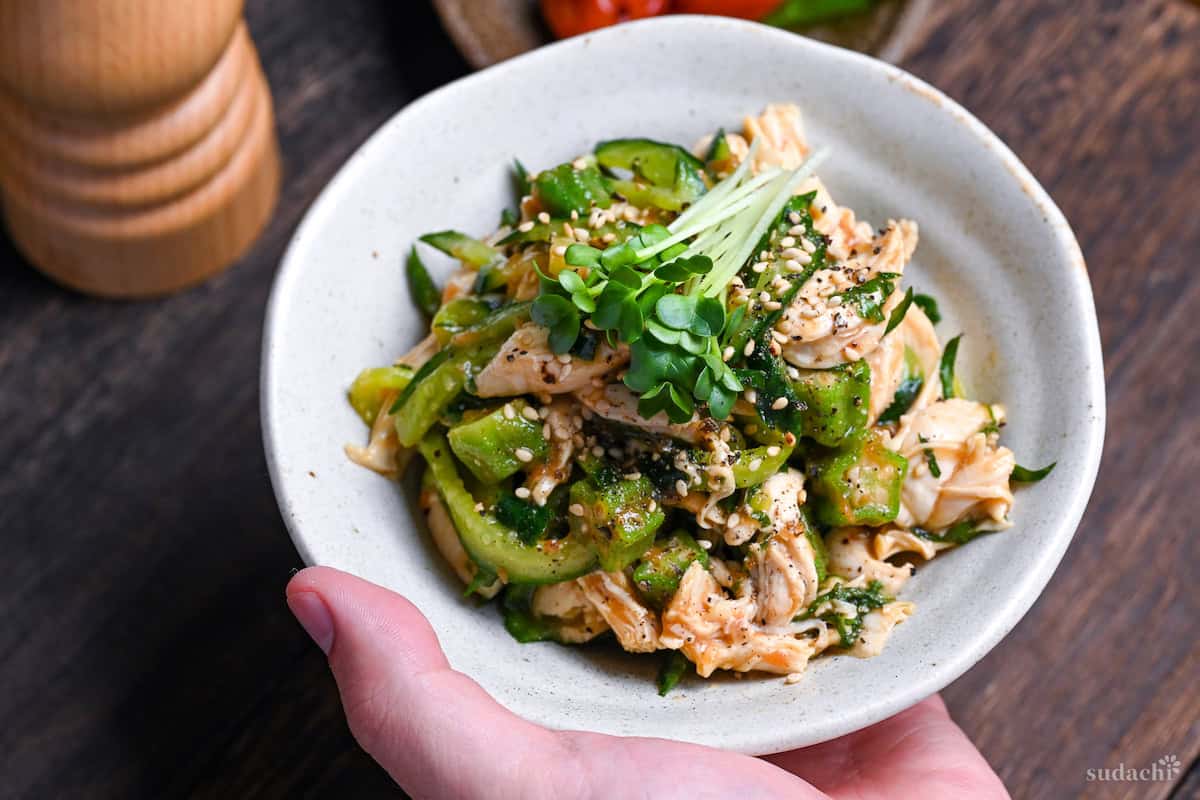
Bright green cucumber & okra, and tender shreds of poached chicken tender mingle in a tangy plum-miso dressing that will make your mouth water. Every bite is fresh and balanced.
What makes this quick salad special is that each ingredient is prepared with great care. Ready to learn every step? Let’s walk through the simple steps that create this crowd-pleasing masterpiece.
Key Ingredients & Substitution Ideas
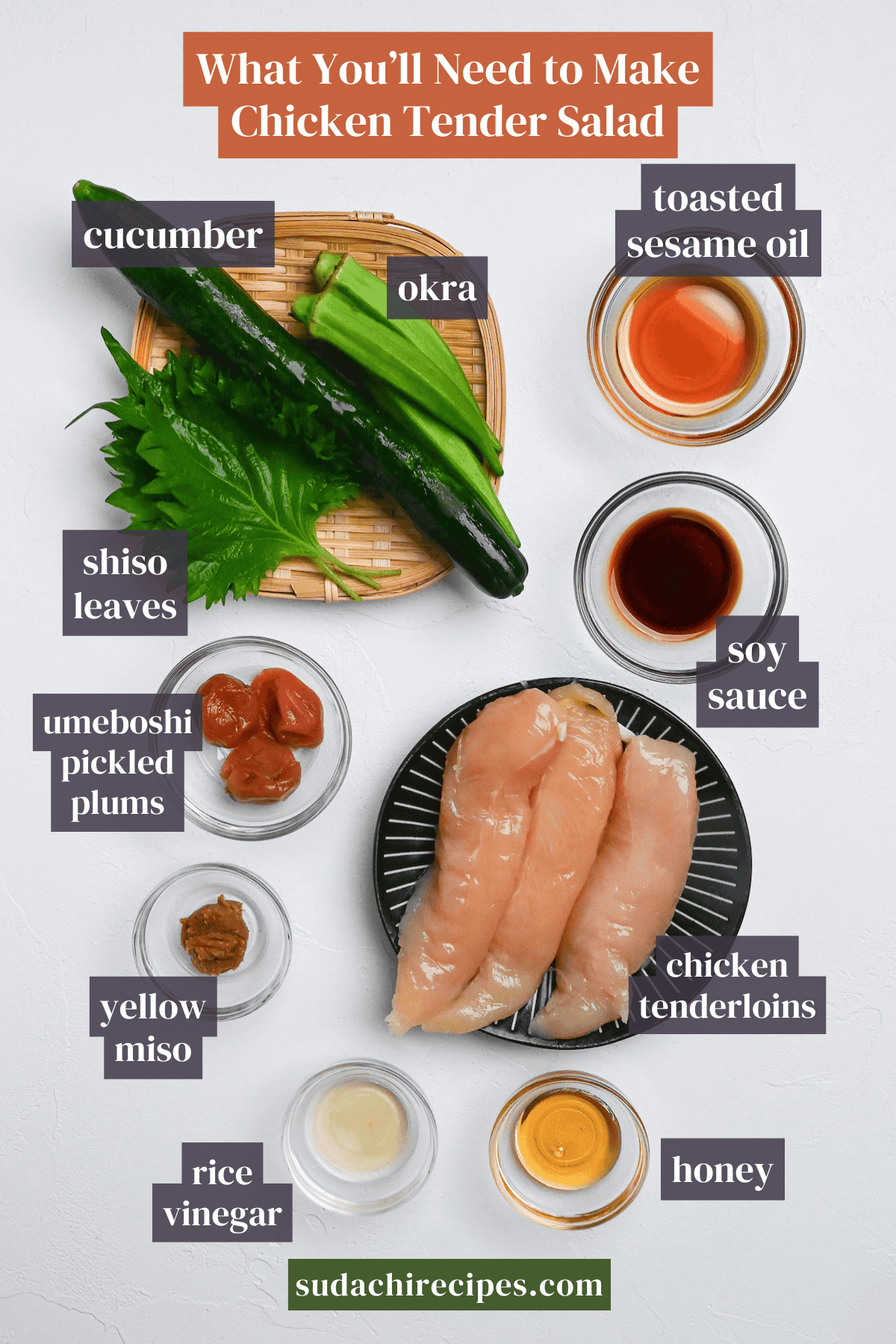
- Chicken tenderloin: Look for pieces with a glossy, firm surface that appear translucent and plump, with no visible liquid seeping out. You can substitute with chicken breast cut into similar-sized strips, but tenders deliver a juicier, more delicate result.
- Toasted sesame oil: This aromatic oil is absolutely essential for bringing all the flavors together, so I do not recommend substituting it. Always choose a bottle labeled “toasted” or “roasted” sesame oil for the deep, nutty flavor this recipe needs.
- Yellow miso: If you need to substitute with a single-variety miso, red miso works better than white miso for this recipe’s flavor profile. If you have both, I recommend mixing them at 50/50 ratio.
Visual Walkthrough & Tips
Here are my step-by-step instructions for how to make Chicken Tender Salad at home. For ingredient quantities and simplified instructions, scroll down for the Printable Recipe Card below.
This section aims to provide a comprehensive overview of the cooking steps and techniques with visuals. It also includes more in-depth tips and tricks and explains why I do what I do.
Start by removing the pits from the umeboshi (pickled plums) and finely chopping the flesh with a knife until it forms a smooth paste. If you can’t find whole umeboshi, store-bought ume paste is a convenient alternative and works well for this recipe.
Look for it in the Japanese section of Asian grocery stores, or you can find it online. The homemade paste from whole umeboshi tends to have a more complex, nuanced flavor.
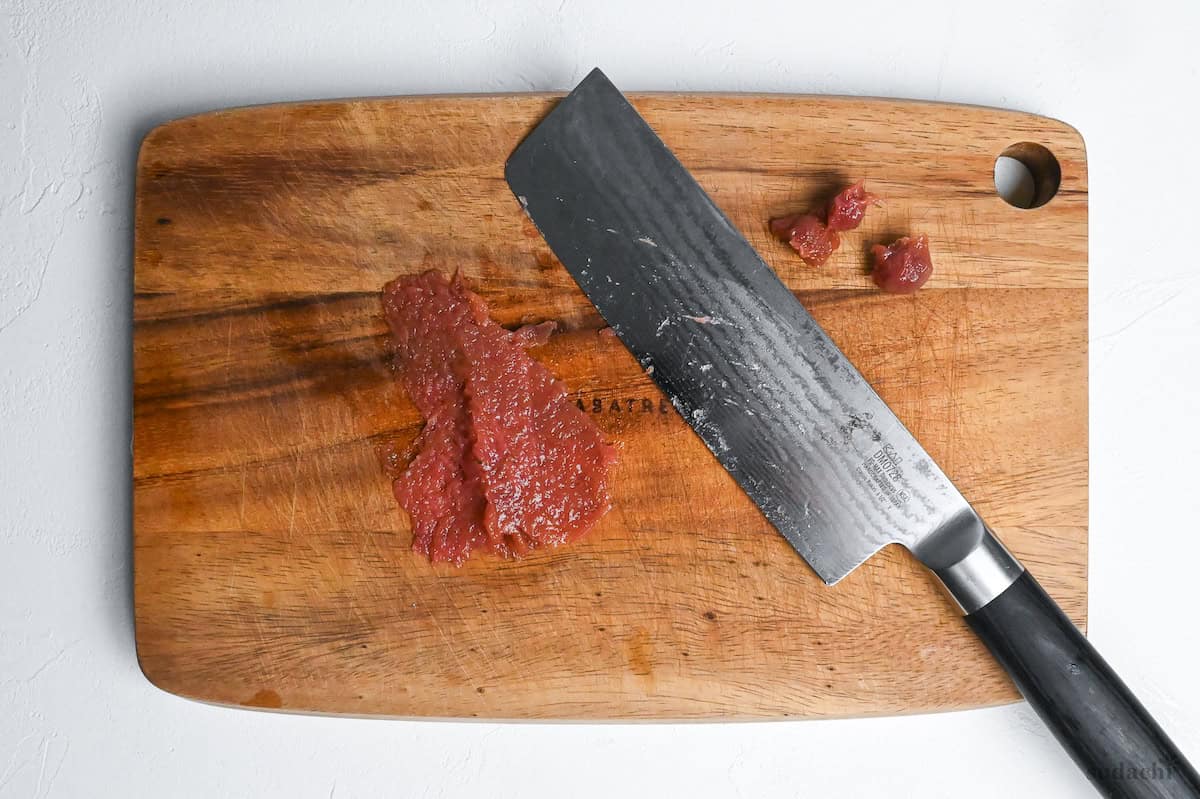
In a mixing bowl, combine the paste with toasted sesame oil, soy sauce, miso, rice vinegar, and honey. Whisk everything together until smooth and well-incorporated.
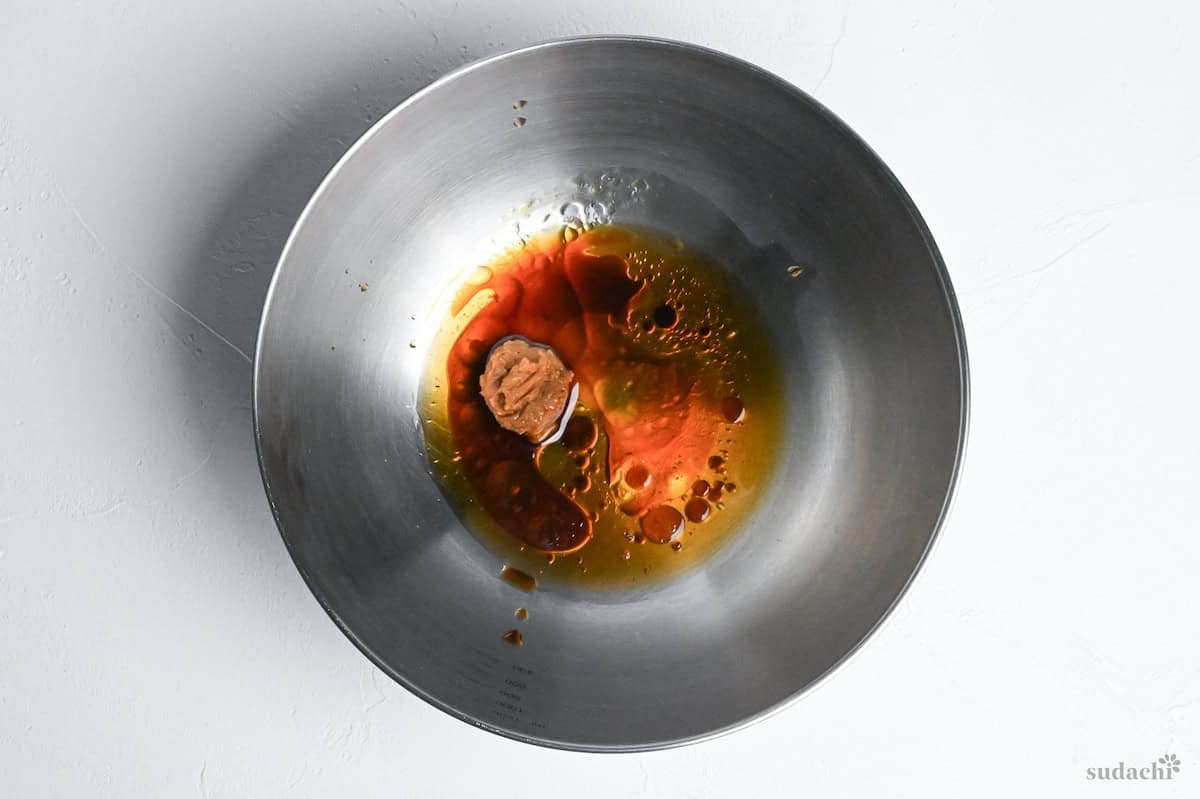
Refrigerate the dressing until you’re ready to use it.
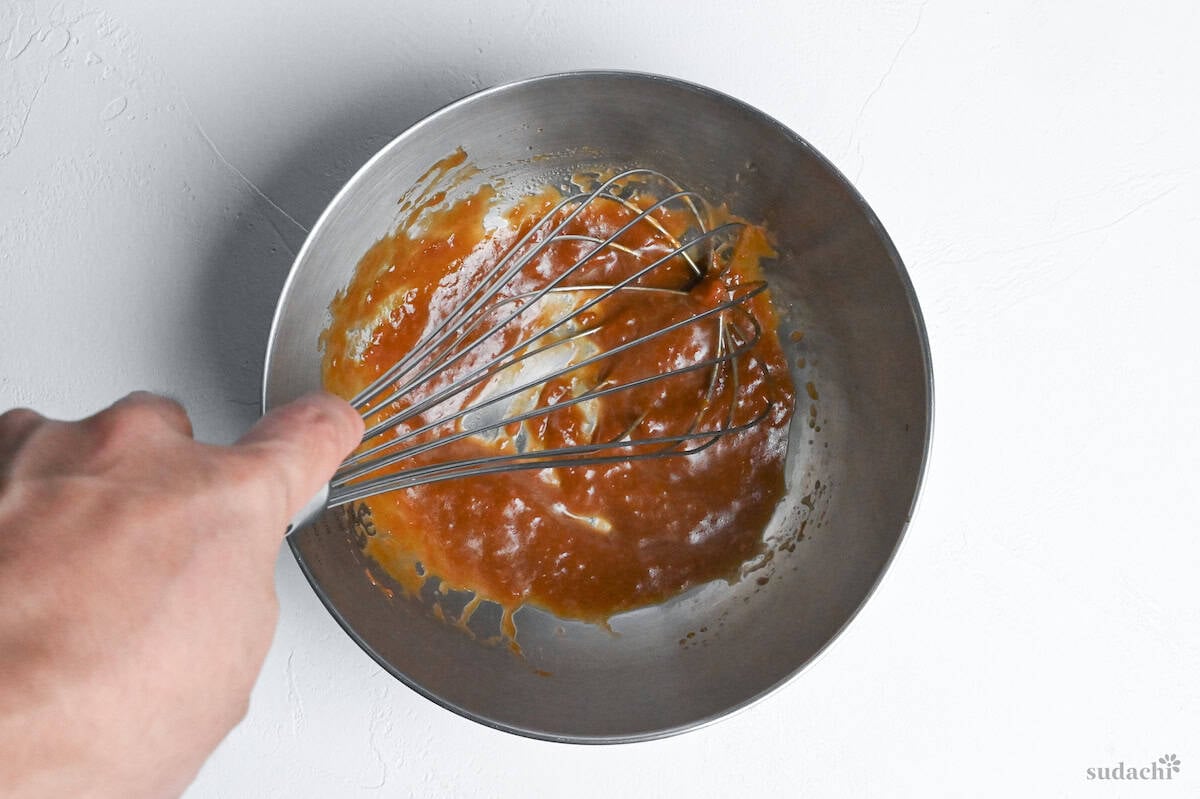
Cut the cucumber diagonally into thin slices. The increased surface area makes it easier to julienne.
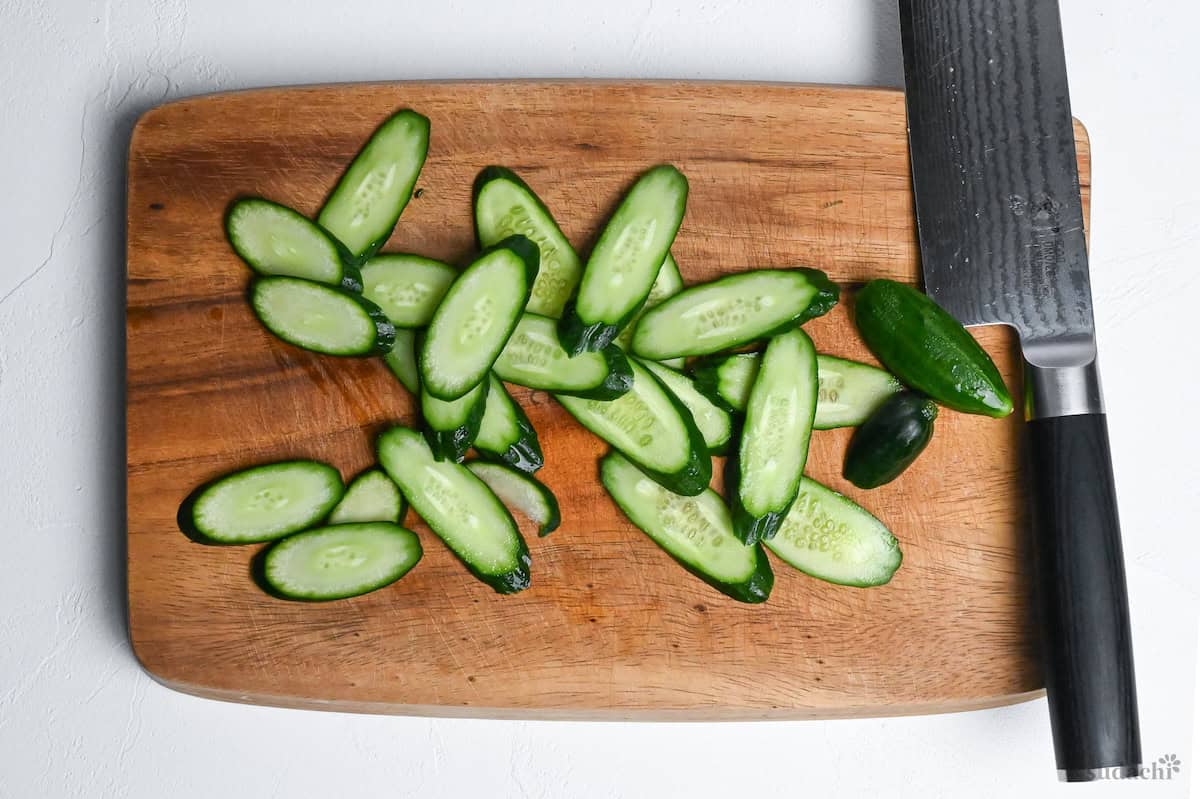
Then stack and cut them into fine matchsticks.
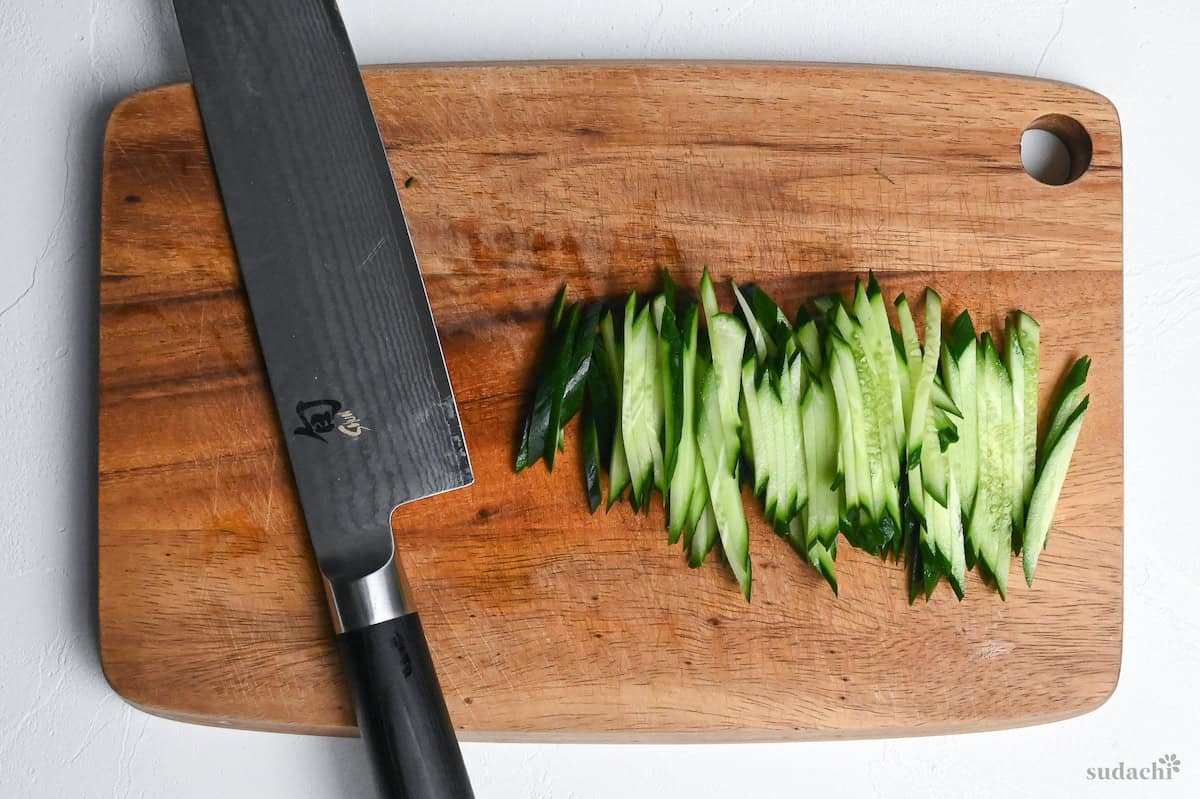
Sprinkle with a pinch of salt, toss, and let sit for about 10 minutes to draw out excess moisture.
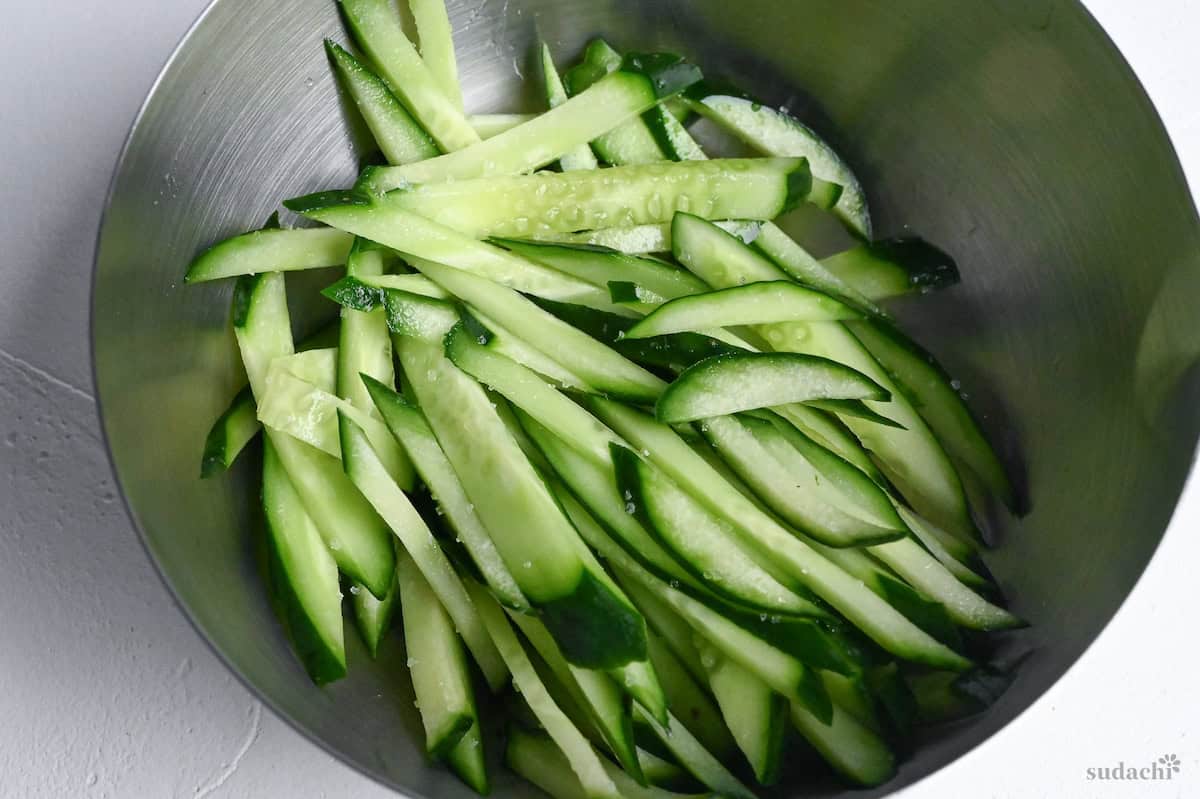
The salt treatment serves two purposes: it removes water that would otherwise dilute your dressing, and it creates microscopic channels that help flavors penetrate the cucumber.
Remove the tough white tendon (also called the sinew) from each chicken tender. Make shallow cuts along both sides of the sinew, cutting about halfway through the length of the tenderloin. This creates access points that make removal much easier.
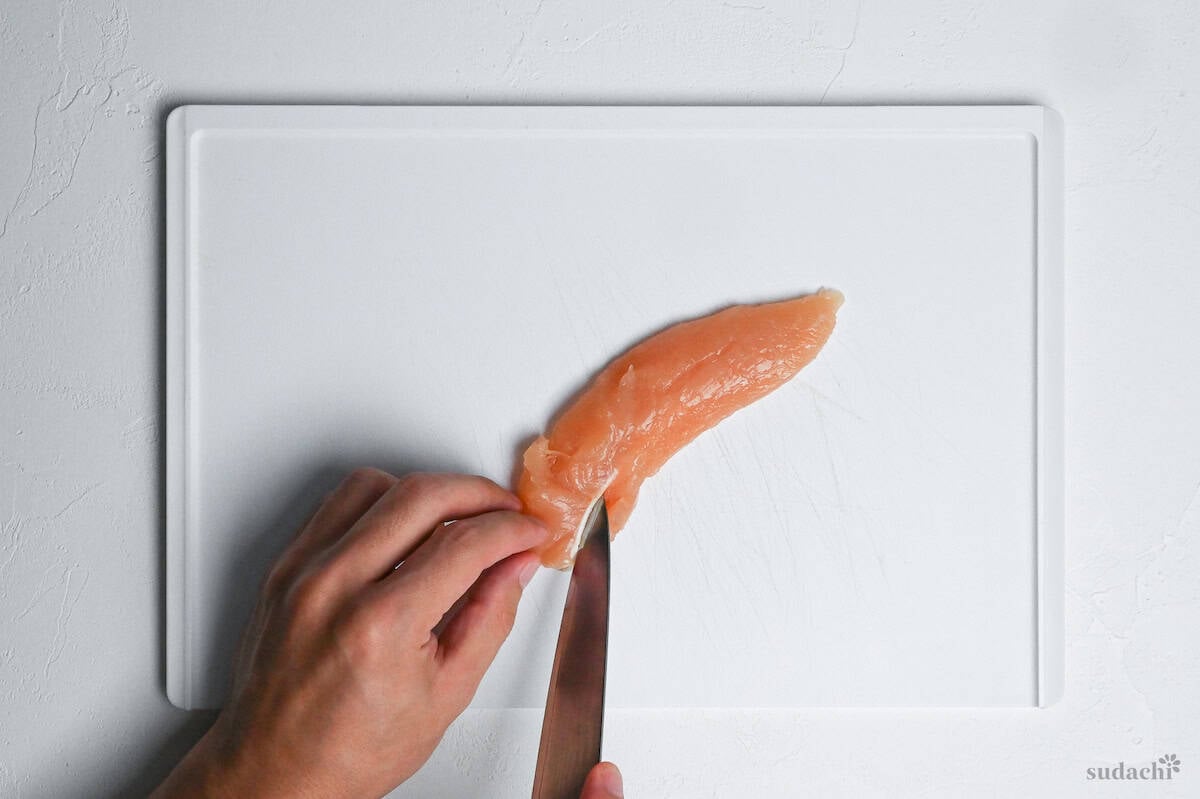
Flip the tenderloin so the sinew faces down against your cutting board. Hold the sinew firmly with your non-dominant hand. If it’s slippery, grip it through a paper towel for better control. Now use the back (spine) of your knife, not the blade.
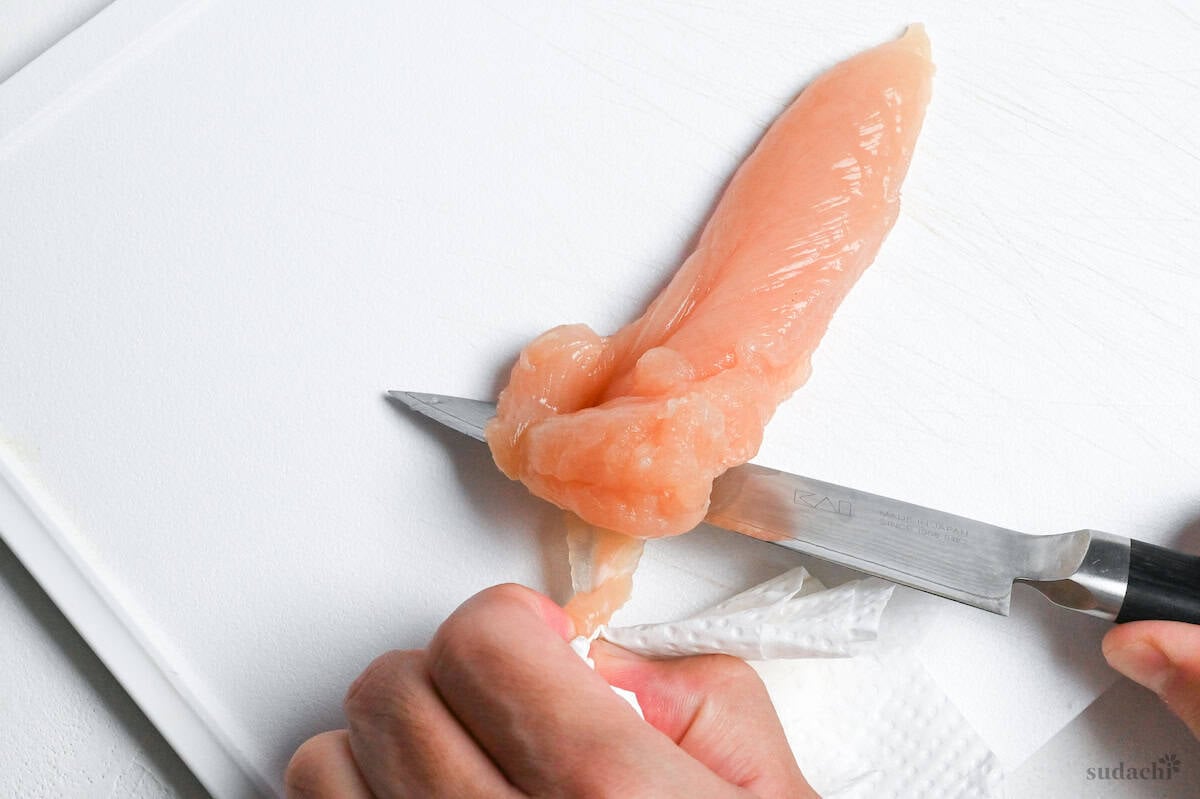
Place the spine of the knife against the sinew and scrape it along the cutting board while maintaining downward pressure. Move the knife in quick up-and-down motions as you work from left to right.
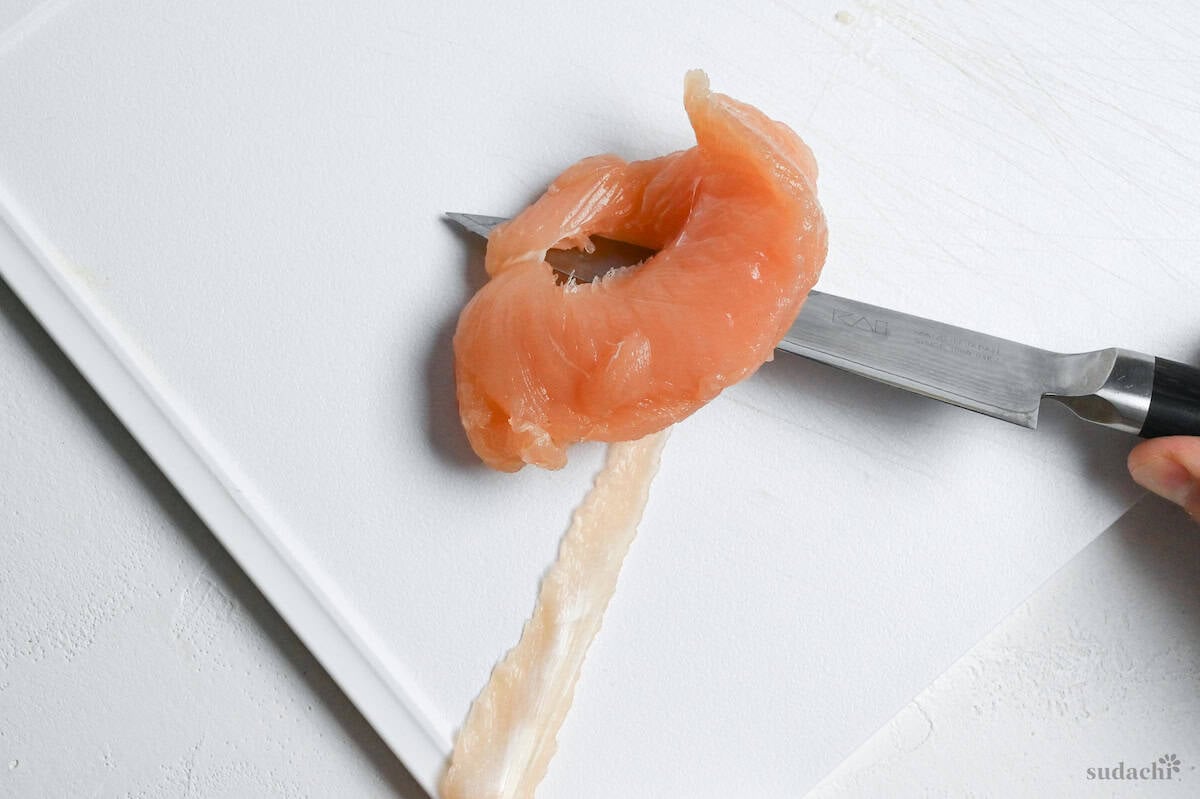
This motion prevents the meat from tearing and ensures clean separation.
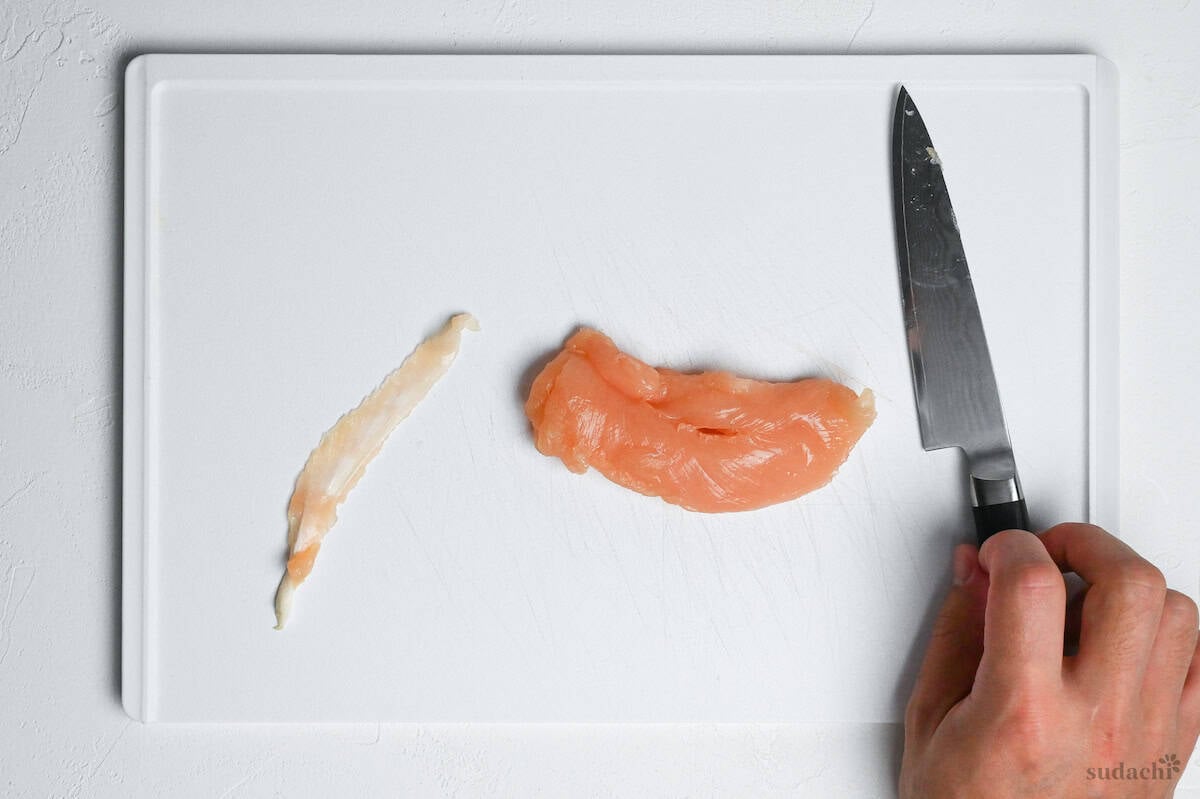
If you find the sinew removal challenging, don’t worry. You can remove it after cooking when the meat is easier to handle. Simply shred the cooked chicken by hand and pick out any tough pieces you encounter.
First, use a knife to carefully shave around the cap (the area around the stem), removing the tough outer layer while being careful not to cut into the seed cavity.
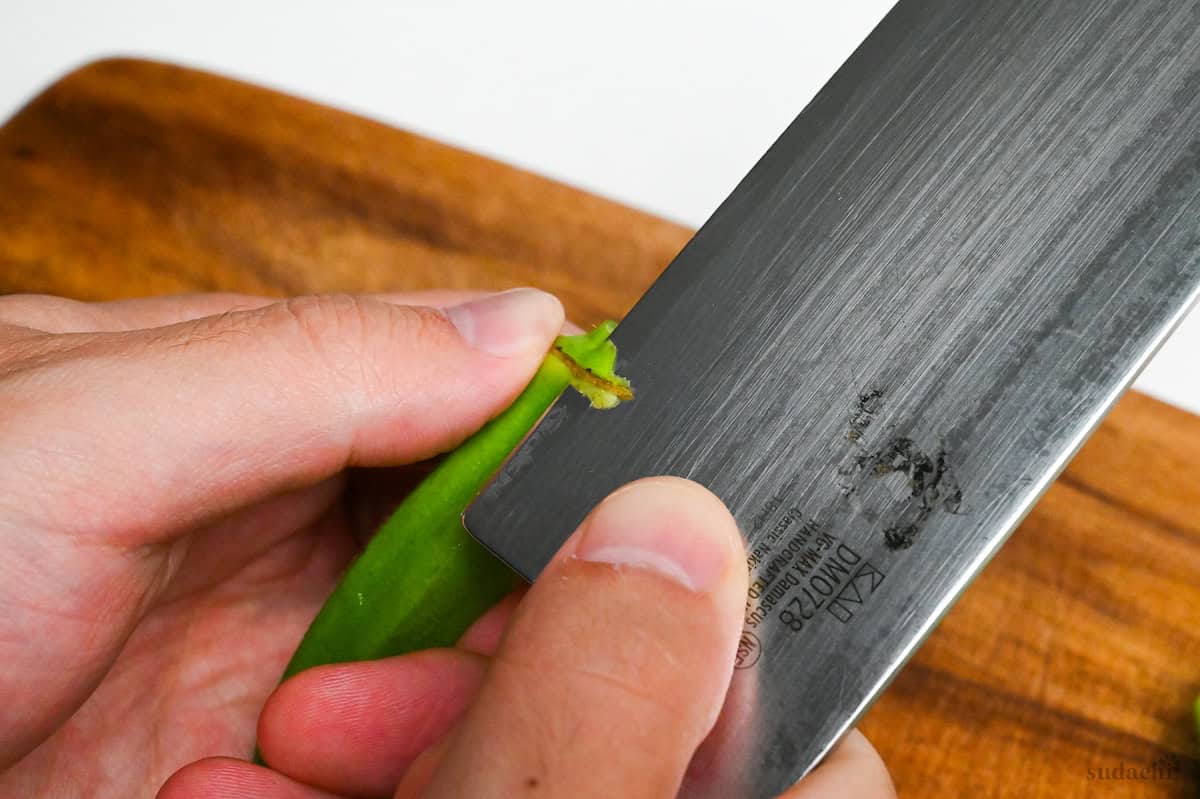
Then, trim off the tough stem end of each okra pod.
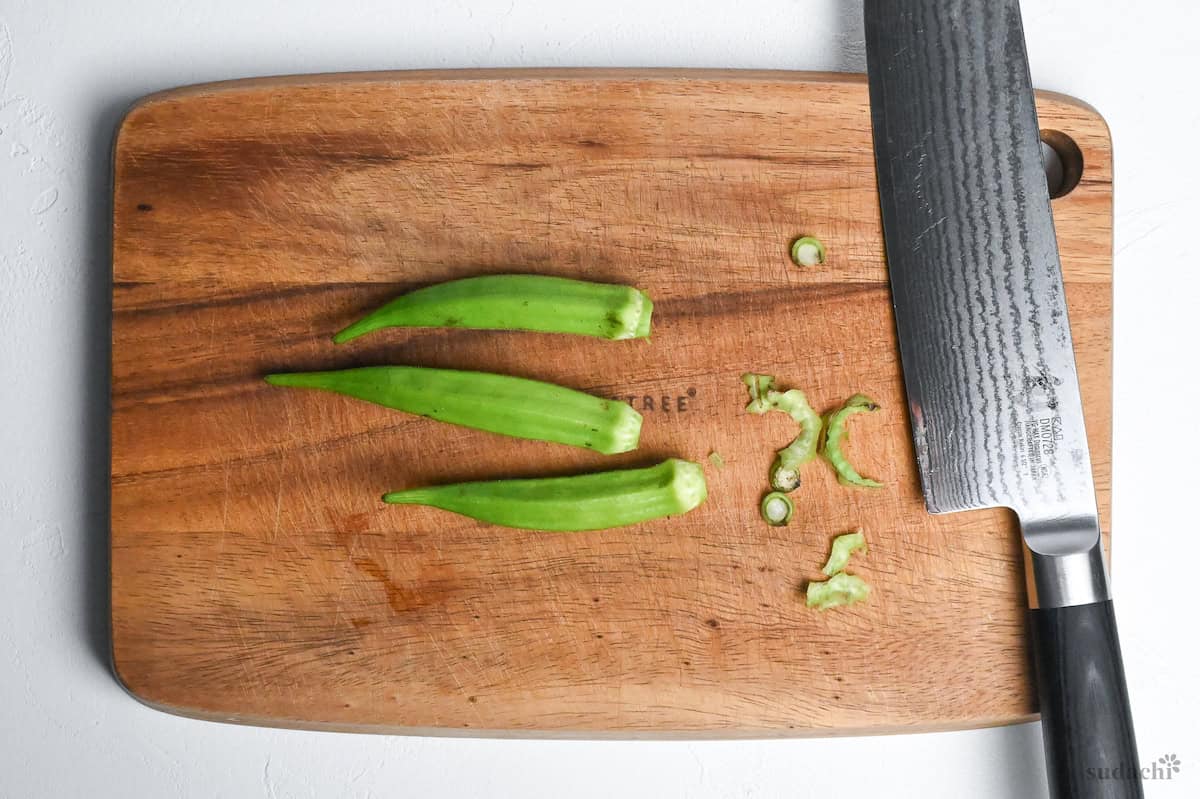
Bring a pot of water to a rolling boil and add salt. This helps the okra retain its vibrant green color during cooking. Add the okra and blanch for exactly 2 minutes.
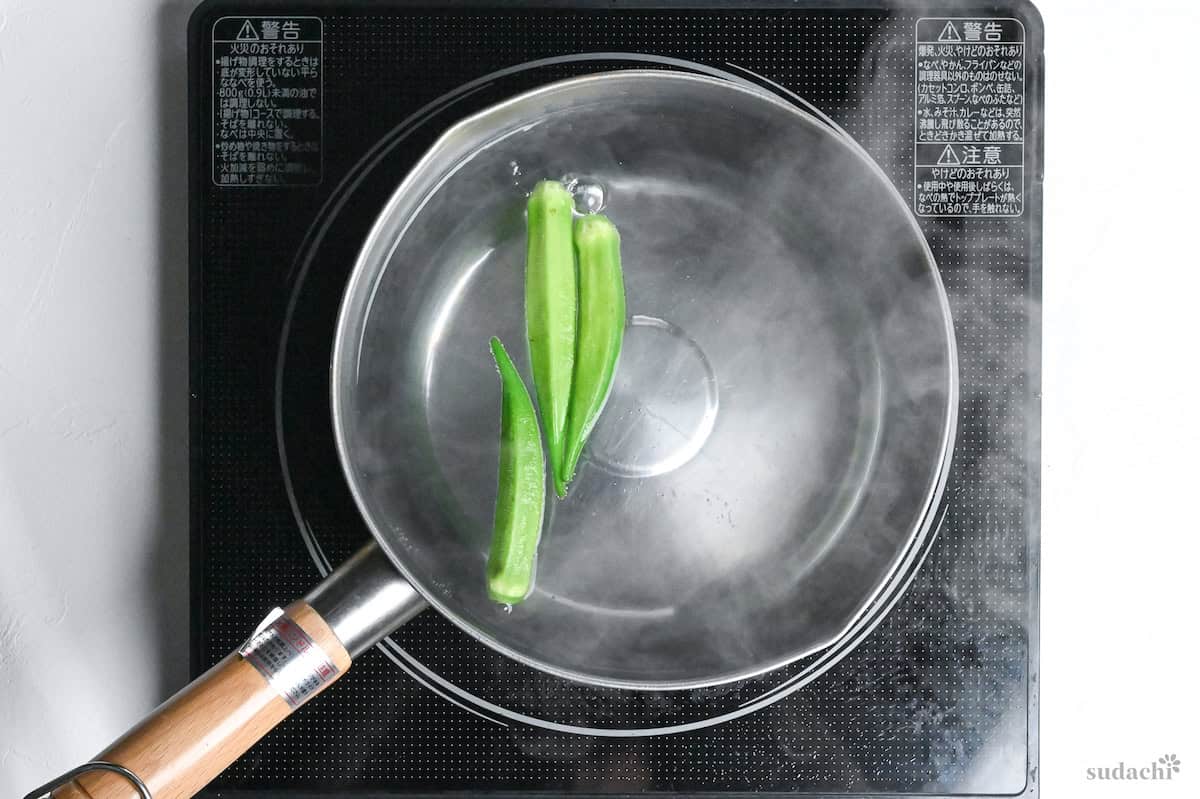
Blanching serves multiple purposes: it brightens the color, improves the mouthfeel, and reduces the natural mucilage that can make okra unpleasantly slimy. The brief cooking time also helps the okra absorb flavors better while maintaining its distinctive texture.
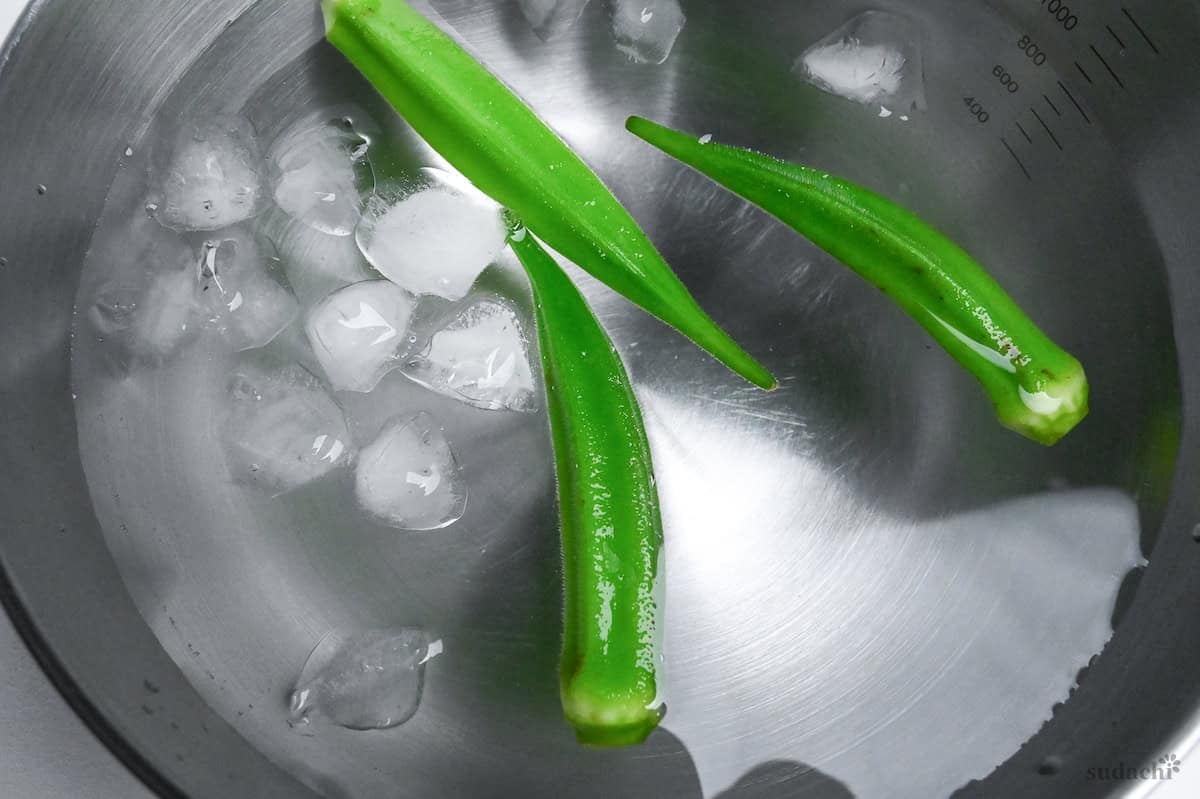
Immediately transfer the blanched okra to an ice bath.
Return the pot to a boil, then turn off the heat and add a splash of sake. Immediately add the chicken tenderloins.
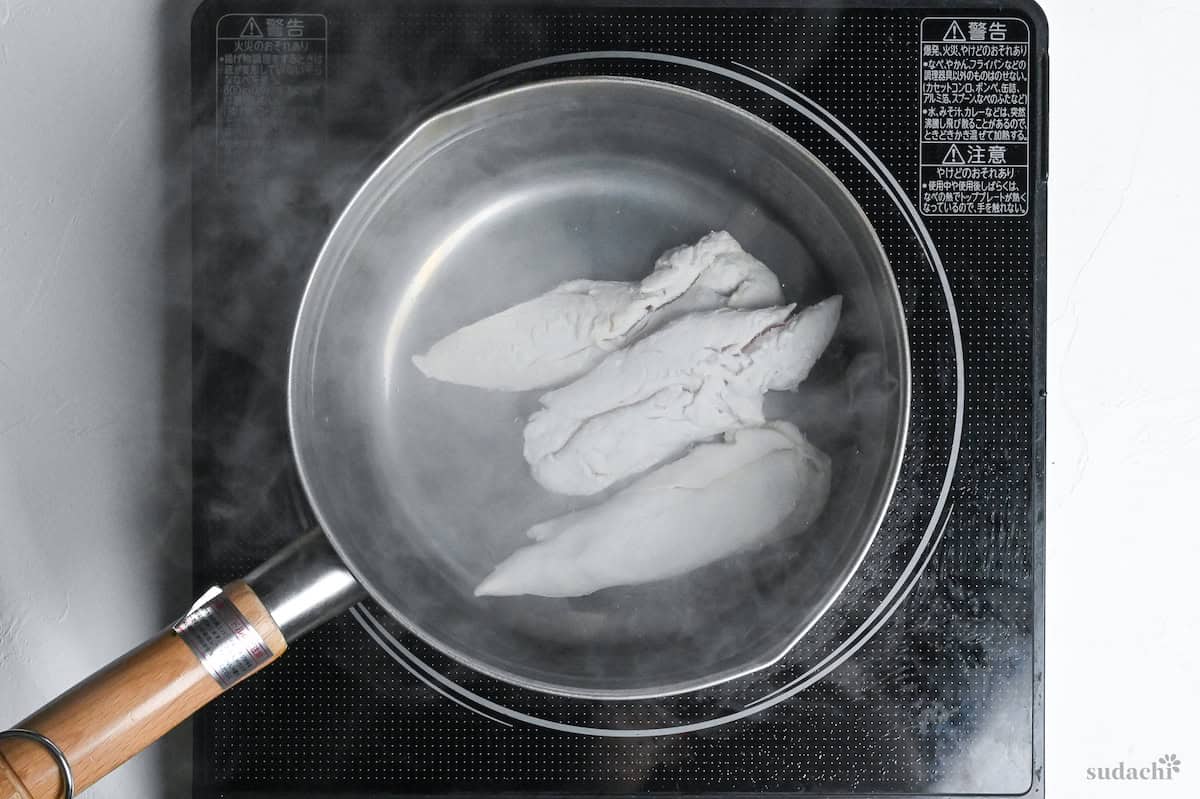
Cover with a lid, and let them poach gently in the residual heat for 7 minutes.
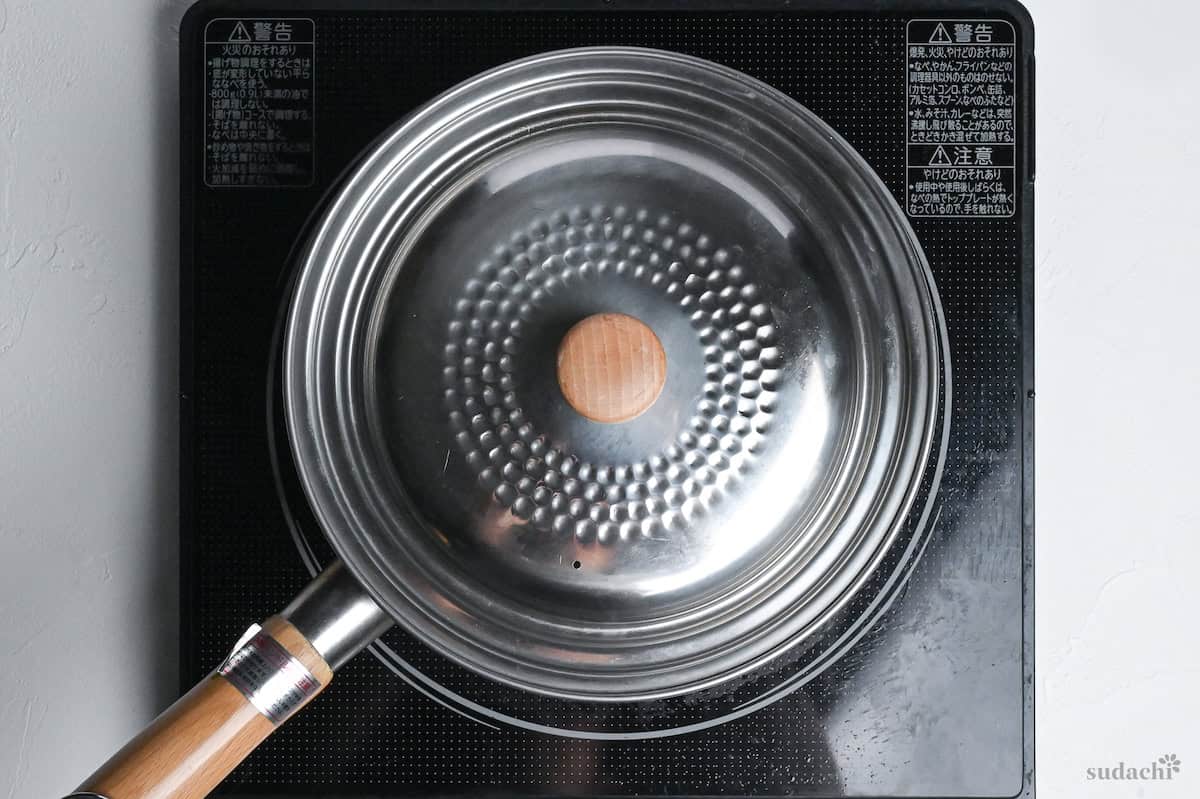
Sake serves two important functions: it neutralizes any gamey flavors in the chicken while also helping to keep the proteins tender.
After 7 minutes, transfer the chicken directly to the ice bath alongside the okra.
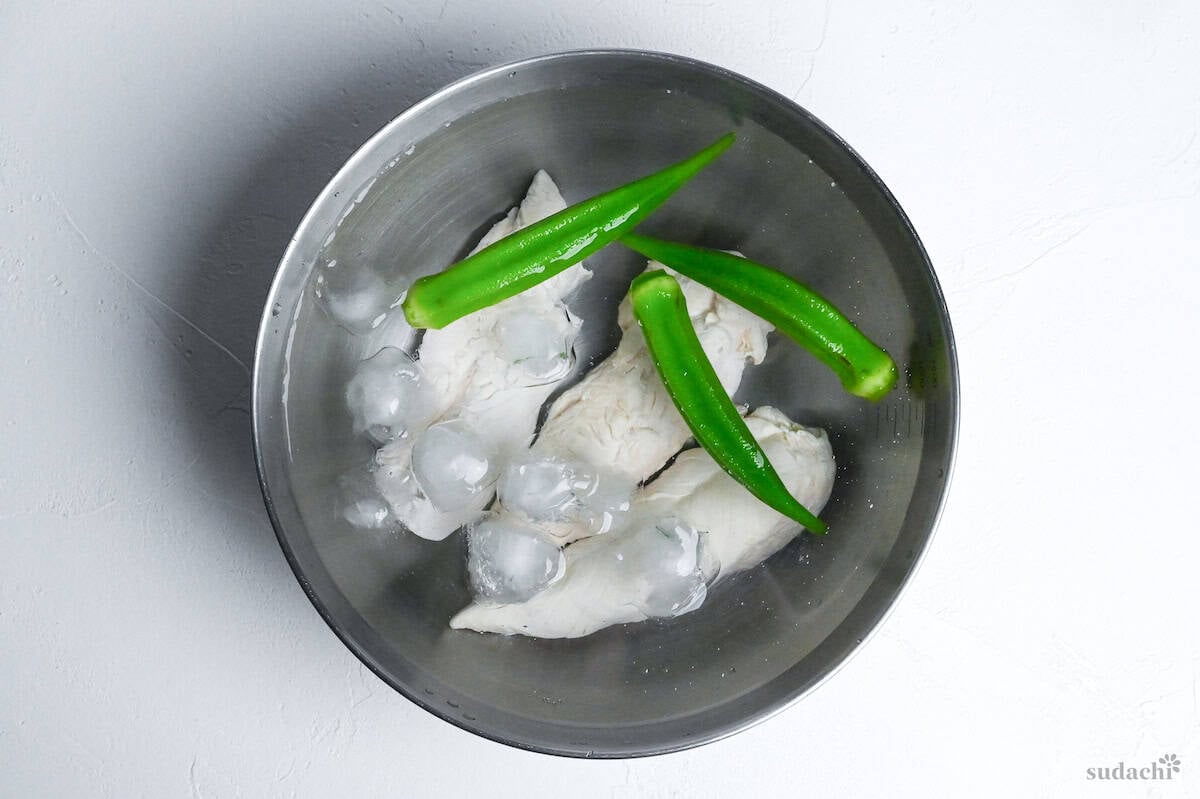
Squeeze the salted cucumbers thoroughly to remove excess moisture. This step is important to avoid a watery final dish.
Slice the blanched okra, then shred the poached chicken by hand. Combine the cucumber, okra, chicken, and shiso leaves in a bowl, and toss well with the chilled dressing.
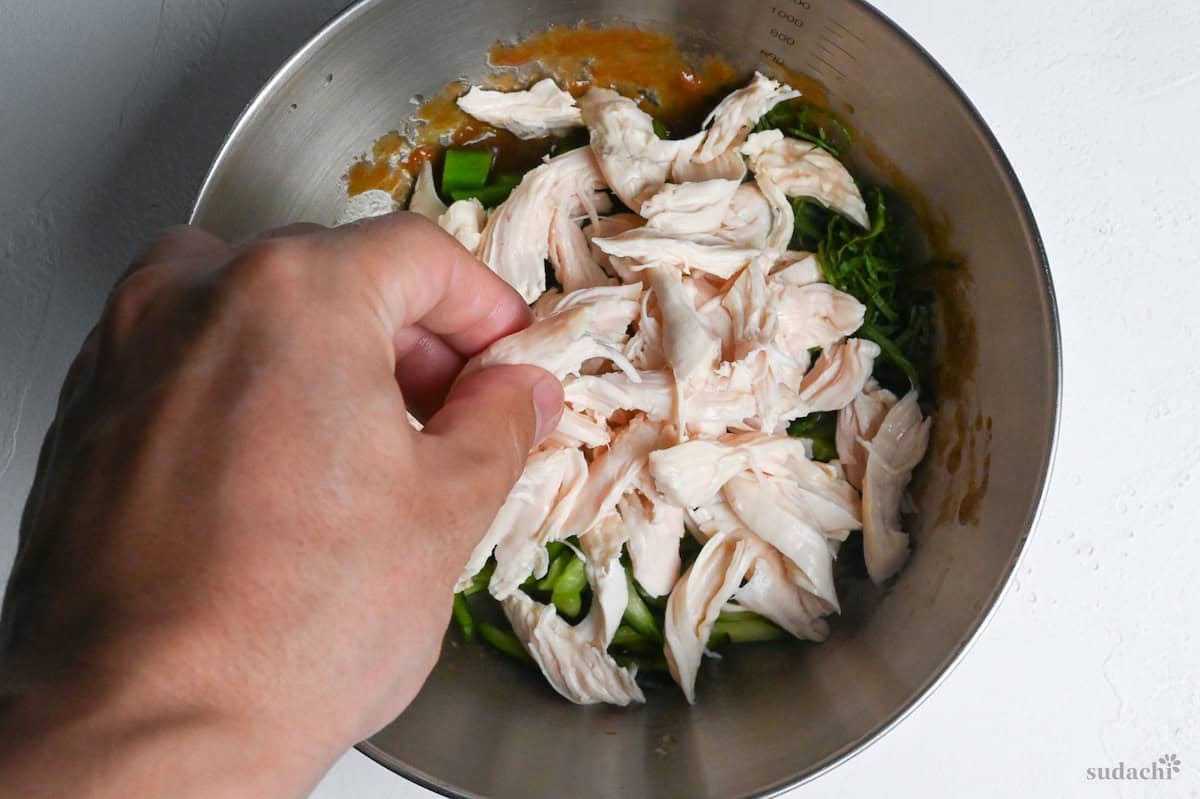
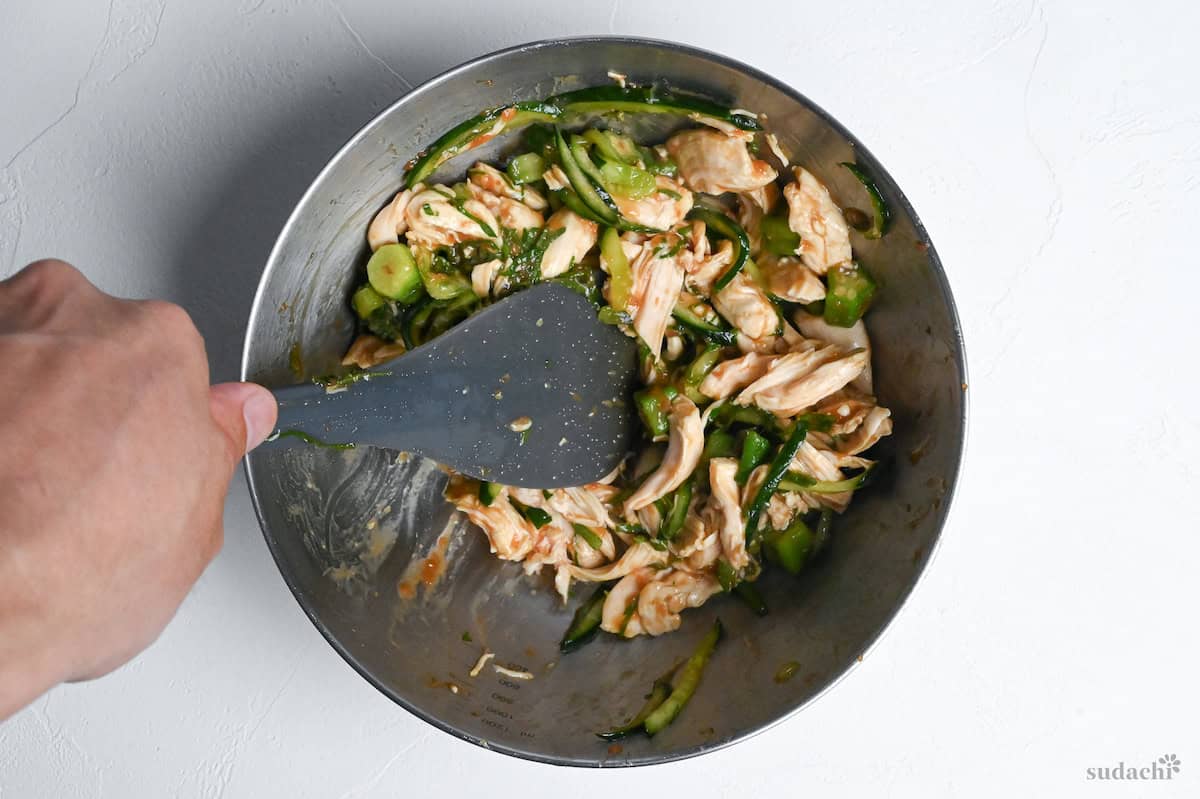
Transfer to your serving plates and finish with a sprinkle of sesame seeds, freshly cracked black pepper, and delicate sprouts for color and a mild peppery bite.
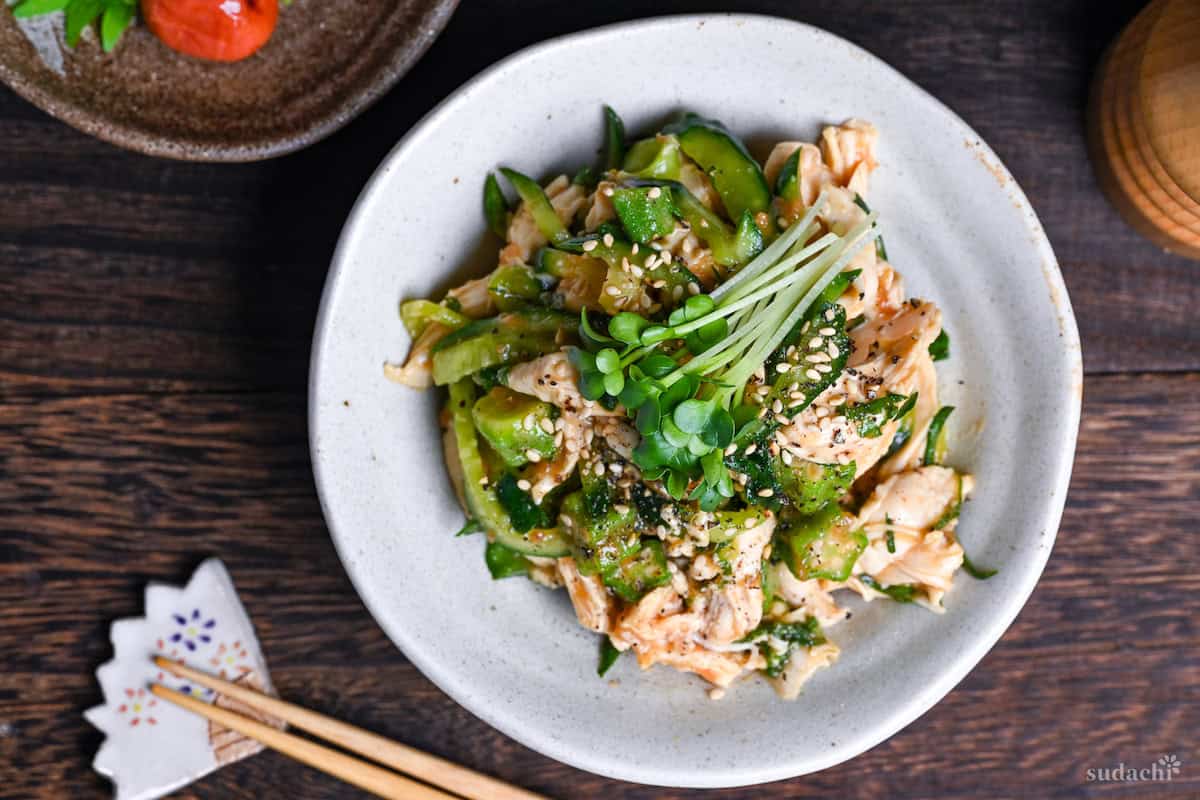

Essential Tips & Tricks
- Turn off the heat completely before adding chicken to the poaching water. Residual heat cooks the chicken gently, preventing it from becoming tough and dry.
- Shred chicken by hand rather than cutting with a knife. Hand-torn pieces have irregular surfaces that hold dressing better than clean cuts.
- Chill the dressing before serving. Cold dressing adheres better to ingredients and the flavors meld more effectively.
With these simple tips in mind, you’re set for success every time you make this chicken salad.
Meal Prep & Storage
This Japanese chicken and okra salad is not ideal for traditional meal prep. The delicate vegetables and dressing combination doesn’t hold up well over time.
The salt-massaged cucumbers will continue releasing water over time, diluting the dressing and making the salad watery. The poached chicken becomes dry when stored in the acidic dressing, and the okra loses its perfect tender-crisp texture.
You can however, prepare each element separately and just mix it right before serving
Component Prep Option:
- Dressing Only: The umeboshi dressing can be made up to 3 days ahead and stored in the refrigerator.
- Chicken Prep: Poach the chicken up to 2 days ahead, store whole (don’t shred), and keep refrigerated in a separate container until ready to assemble.
If you must store the complete salad, consume it within 4-6 hours for best quality. Store in an airtight container in the refrigerator, but expect some texture loss.
Serving Suggestions
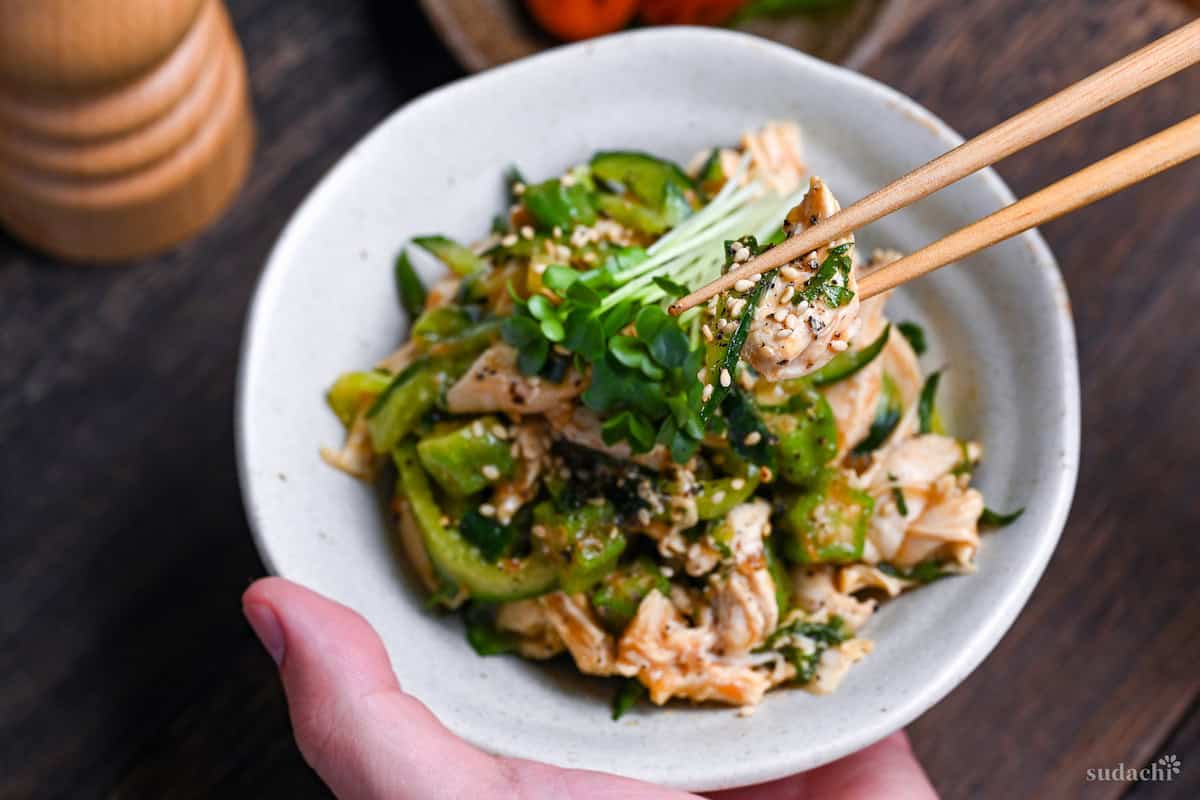
I hope you enjoy this Chicken Salad recipe! If you try it out, I’d really appreciate it if you could spare a moment to let me know what you thought by giving a review and star rating in the comments below. It’s also helpful to share any adjustments you made to the recipe with our other readers. Thank you!
More Salad Recipes
Hungry for more? Explore my salad recipe collection to find your next favorite dishes!
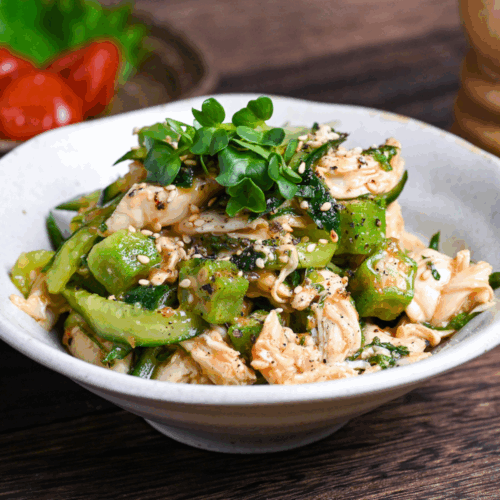
Poached Chicken Tender Salad with Fruity Japanese Dressing
Ingredients
- 1 Japanese cucumber or Persian cucumber
- salt
- 3 okra
- 3 pieces chicken tenderloin
- 1 tbsp sake optional
- 4 shiso leaves shredded
Dressing
- 3 pickled plums (umeboshi) or 2 tbsp store-bought ume paste
- 1 tbsp toasted sesame oil
- ½ tbsp Japanese soy sauce (koikuchi shoyu)
- 1 tsp yellow miso paste (awase)
- 1 tsp rice vinegar
- 1 tsp honey
Toppings
- toasted white sesame seeds to taste
- ground black pepper to taste
- broccoli sprouts to taste
My recommended brands of ingredients and seasonings can be found in my Japanese pantry guide.
Can’t find certain Japanese ingredients? See my substitution guide here.
Instructions
- Remove the pits from 3 pickled plums (umeboshi) and use a knife to finely chop the flesh until it resembles a smooth paste.

- Add the ume paste to a large mixing bowl along with 1 tbsp toasted sesame oil, ½ tbsp Japanese soy sauce (koikuchi shoyu), 1 tsp yellow miso paste (awase), 1 tsp rice vinegar and 1 tsp honey. Whisk until smooth and store in the fridge for later.

- Diagonally slice 1 Japanese cucumber.

- Stack the slices and cut them into thin matchsticks, then place them in a bowl and sprinkle with a pinch of salt. Toss the bowl a few times to evenly distribute the salt, then let it sit for 10 minutes.

- Bring a large pot of water to a boil. While you wait, take 3 okra, cut off the stems and carefully peel the tough area around the top. Be careful not to cut into the seed cavity.

- Take 3 pieces chicken tenderloin and make shallow cuts on both sides of the tendon. Hold the tendon and place the blunt side of your knife firmly on top of it, then pull it out. The back of the knife will separate the chicken meat from the tendon.

- Once the water is boiling, add the okra to the pot and boil for 2 minutes.

- Use a slotted spoon to transfer the okra to an ice water bath. Add 1 tbsp sake to the pot and let it boil once more, then turn off the heat. Place the chicken tenders in the pot and cover with a lid. Leave the chicken to cook in the residual heat for 7 minutes.

- After the timer sounds, transfer the chicken to ice water bath with the okra (add more ice if necessary).

- Squeeze the cucumber thoroughly to remove the excess water, and shred 4 shiso leaves. Dry the okra and cut them into bitesize pieces. Take the dressing from the fridge and add all of the vegetables.

- Once the chicken is cool enough to touch, drain the bowl of ice water and pat the chicken dry with kitchen paper. Shred it by hand straight into the bowl with the dressing.

- Mix until all the ingredients are evenly covered, then transfer to serving bowls with a sprinkle of toasted white sesame seeds, ground black pepper and broccoli sprouts. Enjoy!

Notes
- Choose firm, bright green okra without brown spots or soft areas for the best texture and flavor.
- Adjust honey quantity based on the saltiness of your umeboshi. Saltier plums may need slightly more honey for balance.
- Store assembled salad in the refrigerator for up to 24 hours, though cucumber may release more water over time.
- Serving ideas: Salt Grilled Salmon, Dashimaki Tamago, Japanese Miso Soup, Salmon Onigiri
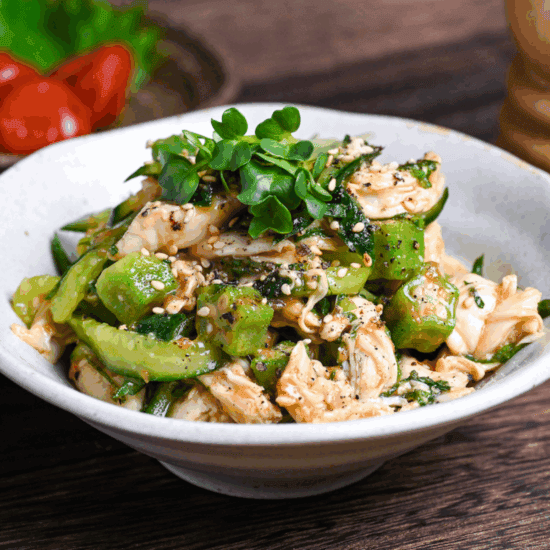


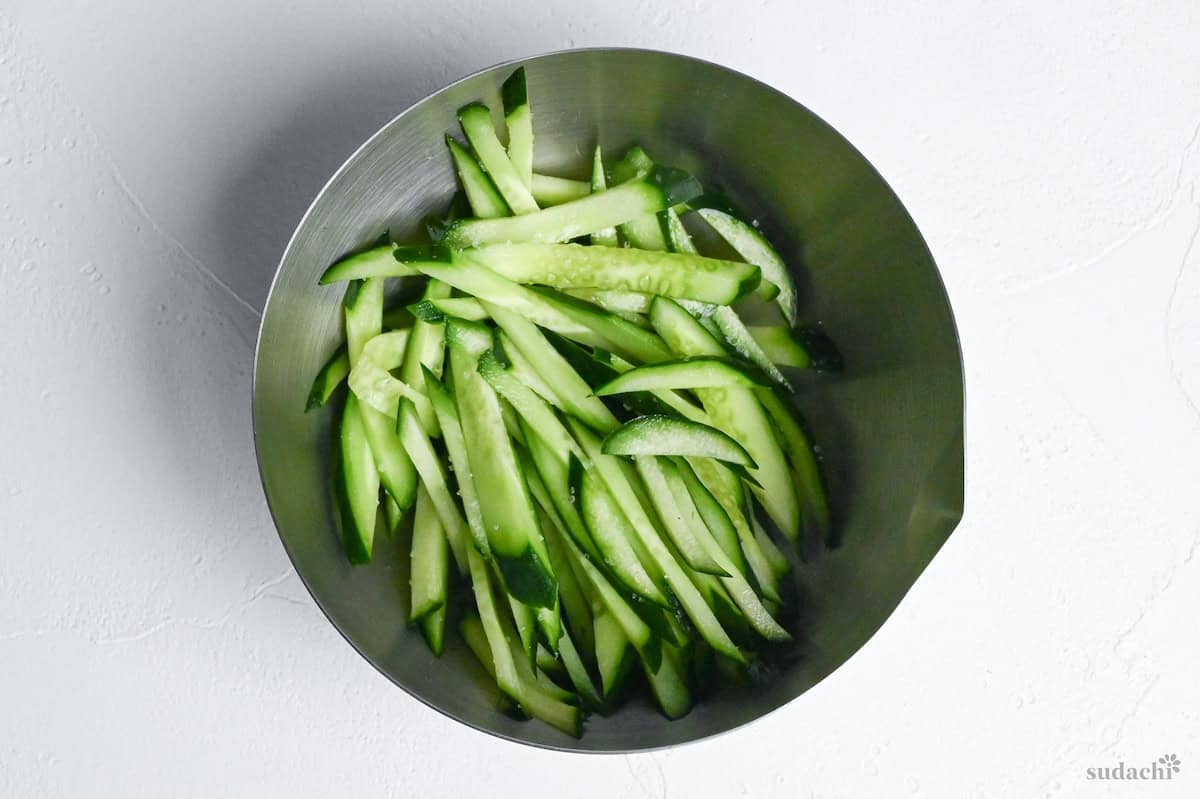
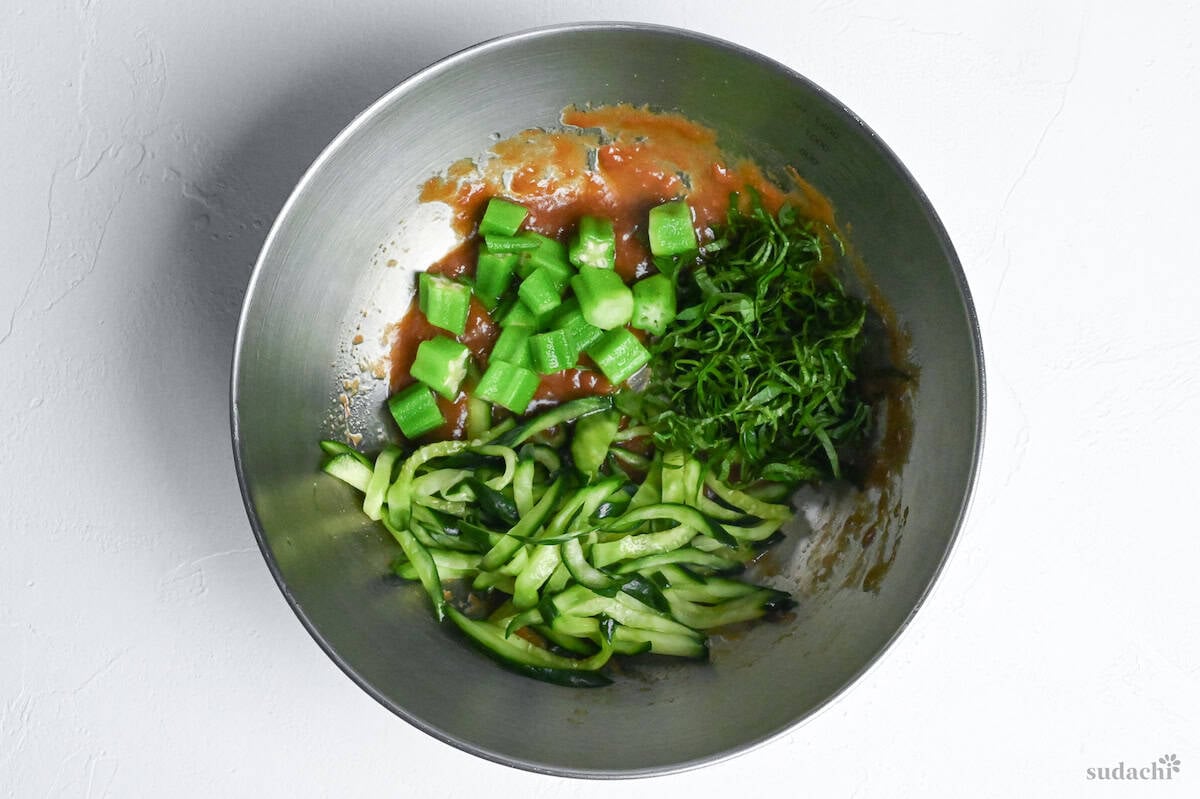
Leave a rating and a comment